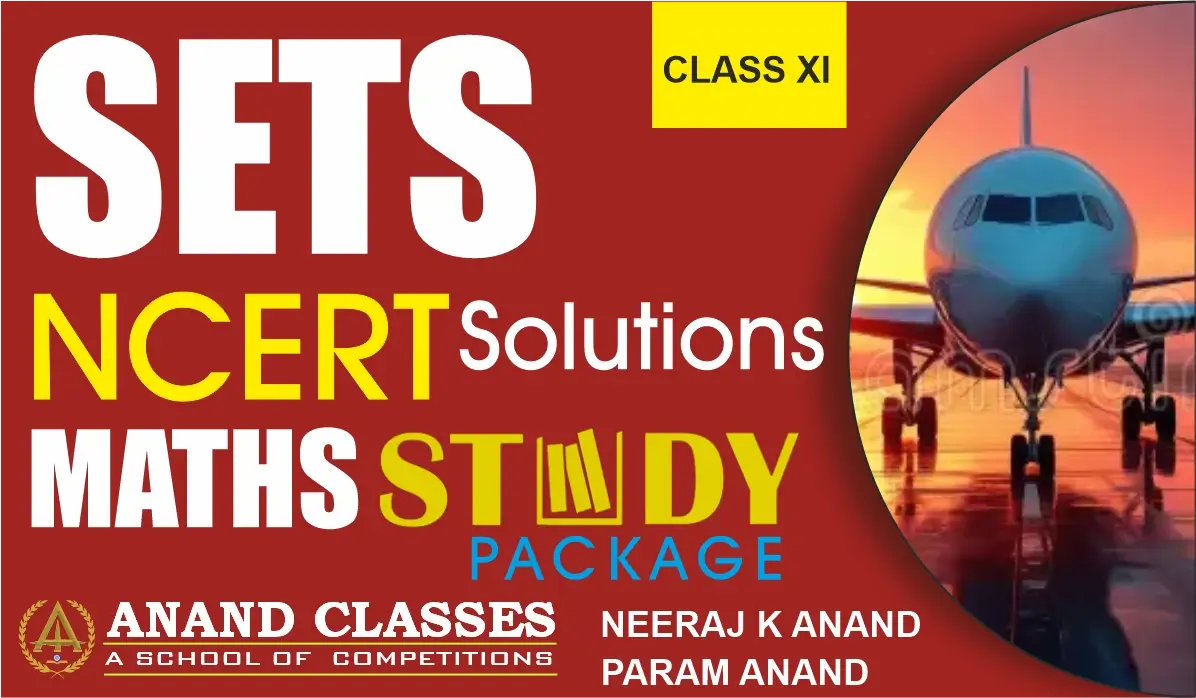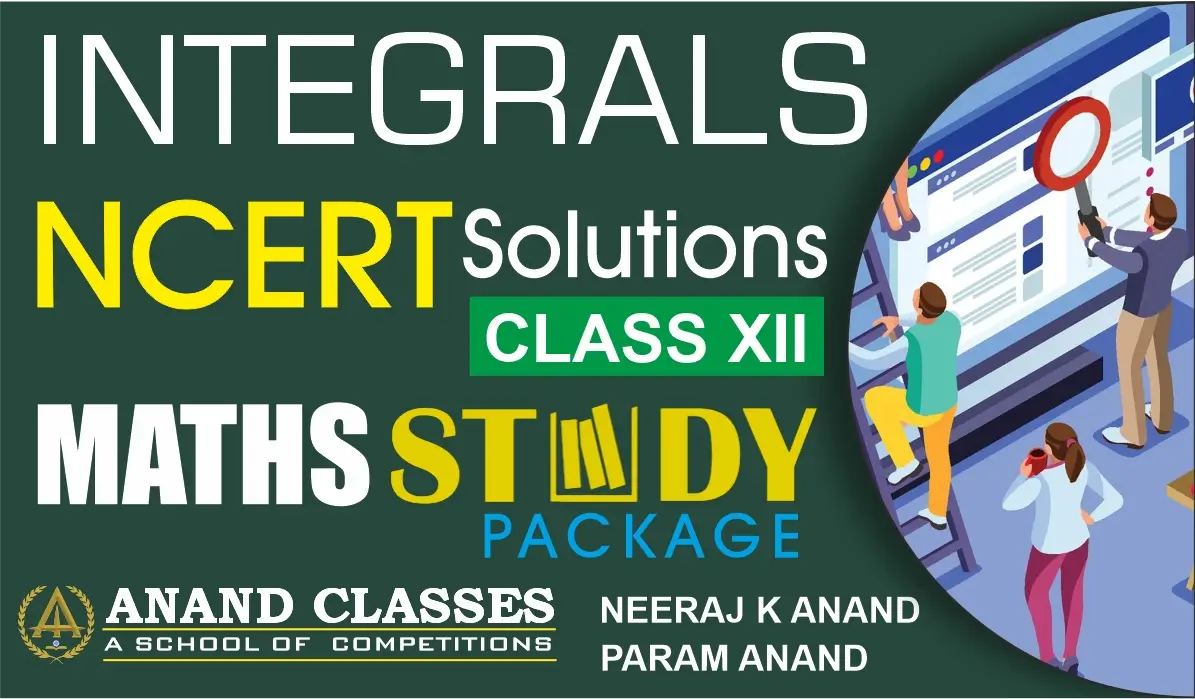Anand Classes provides detailed and accurate Sets Chapter – 1 Exercise 1.2 NCERT Solutions Class 11 Maths to help students understand fundamental concepts of sets with ease. These step-by-step solutions are prepared according to the latest NCERT and CBSE syllabus, ensuring complete clarity and strong conceptual understanding. Perfect for Class 11 students preparing for exams, these solutions make learning and revision simple, systematic, and effective. Click the print button to download study material and notes.
NCERT Question 1 : Which of the following are examples of the null set?
(i) Set of odd natural numbers divisible by 2
(ii) Set of even prime numbers
(iii) { x : x is a natural numbers, x < 5 and x > 7 }
(iv) { y : y is a point common to any two parallel lines}
Solution :
(i) Set of odd natural numbers divisible by 2
✅ Yes, this is a null set because there is no odd natural number divisible by 2.
(ii) Set of even prime numbers
❌ No, this is not a null set because $2$ is an even number which is prime.
(iii) ${x : x \text{ is a natural number},\ x < 5 \text{ and } x > 7}$
✅ Yes, this is a null set because there is no natural number less than $5$ and greater than $7$.
(iv) ${y : y \text{ is a point common to any two parallel lines}}$
✅ Yes, this is a null set because two parallel lines do not intersect.
Note: A set which does not contain any element is called a null set.
NCERT Question 2 : Which of the following sets are finite or infinite?
(i) The set of months of a year
(ii) {1, 2, 3, . . .}
(iii) {1, 2, 3, . . .99, 100}
(iv) The set of positive integers greater than 100
(v) The set of prime numbers less than 99
Solution :
(i) The set of months of a year
✅ Finite — There are $12$ months in a year.
(ii) ${1, 2, 3, \dots}$
♾ Infinite — Set of natural numbers.
(iii) ${1, 2, 3, \dots, 99, 100}$
✅ Finite — Contains $100$ numbers.
(iv) The set of positive integers greater than $100$
♾ Infinite — Positive integers continue endlessly.
(v) The set of prime numbers less than $99$
✅ Finite — Only limited primes below $99$.
Note: A set with a definite number of elements is finite, otherwise infinite.
NCERT Question 3 : State whether each set is finite or infinite:
(i) The set of lines which are parallel to the x-axis
(ii) The set of letters in the English alphabet
(iii) The set of numbers which are multiple of 5
(iv) The set of animals living on the earth
(v) The set of circles passing through the origin (0,0)
Solution :
(i) The set of lines parallel to the x-axis
✅ Infinite. We can draw infinite parallel lines with respect to the x-axis.
(ii) The set of letters in the English alphabet
✅ Finite — $26$ letters
(iii) The set of multiples of $5$
✅ Infinite — ${5, 10, 15, \dots}$
(iv) The set of animals living on the earth
✅ Finite — Countable species exist
(v) The set of circles passing through the origin $(0,0)$
✅ Infinite — Different radius possible
NCERT Question 4 : State whether $A = B$ or not
(i) A = { a, b, c, d } , B = { d, c, b, a }
(ii) A = { 4, 8, 12, 16 } , B = { 8, 4, 16, 18}
(iii) A = {2, 4, 6, 8, 10} , B = { x : x is positive even integer & x ≤ 10}
(iv) A = { x : x is a multiple of 10}, B = { 10, 15, 20, 25, 30, . . . }
Solution :
(i)
Yes. Every element of A is also an element of B and every element of B is also an element of A namely {a, b, c, d}.
Note: Two sets A and B are said to be equal if they have exactly the same elements, and we write A = B. Otherwise, the sets are said to be unequal, and we write A ≠ B. Order in which elements appear does not matter.
$$A = \{a, b, c, d\},\quad B = \{d, c, b, a\}$$
✅ Yes, $A = B$
(ii)
$$A = \{4, 8, 12, 16\},\quad B = \{8, 4, 16, 18\}$$
No. 12 is an element that is present in A but not in B and similarly 18 is an element present in B not in A.
❌ No A ≠ B — $12 \notin B$ and $18 \notin A$
(iii)
$$A =\{2, 4, 6, 8, 10\}$$
$$B = \{x : x \text{ is positive even integer and } x \le 10\}$$
Yes. If we define set B it can be written like this {2, 4, 6, 8, 10} and therefore every element of A is also an element of B and every element of B is also an element of A.
✅ Yes — Both sets represent the same elements
(iv)
$$A = \{x : x \text{ is a multiple of } 10\}$$
$$B = \{10, 15, 20, 25, 30, \dots\}$$
No. If we define B we can clearly see that {-40, -30, -20, -10, 0}. All these numbers are also multiples of 10, and they are not in set B. Hence A ≠ B.
❌ No — $B$ contains numbers not multiples of $10$ and also misses negatives, $0$ etc.
NCERT Question 5 : Are the following pairs of sets equal?
(i) A = {2, 3}, B = {x : x is solution of x2 + 5x + 6 = 0}
(ii) A = { x : x is a letter in the word FOLLOW}, B = { y : y is a letter in the word WOLF}
Solution :
(i)
$$A = \{2, 3\}$$
$$B = \{x : x^2 + 5x + 6 = 0\}$$
Solve the equation:
$$x^2 + 5x + 6 = 0$$
$$(x+2)(x+3) = 0$$
$$x = -2, -3$$
So,
$$B = \{-2, -3\}$$
❌ Not equal — different elements
(ii)
$$A = \{x : x \text{ is a letter in the word FOLLOW}\}$$
$$B = \{y : y \text{ is a letter in the word WOLF}\}$$
Both sets contain:
$$\{F, O, L, W\}$$
✅ Yes — They are equal
NCERT Question 6 : From the sets given below, select equal sets:
A = {2, 4, 8, 12}, B = {1, 2, 3, 4}, C = {4, 8, 12, 14}, D = {3, 1, 4, 2}, E = {-1, 1}, F = {0, a}, G = {1, -1}, H = {0, 1}
Solution :
$A$ and $B$ are said to be equal if they have exactly the same elements.
For $A$,
$8 \in A$, but
$8 \notin B,\ 8 \notin D,\ 8 \notin E,\ 8 \notin F,\ 8 \notin G,\ 8 \notin H$
Hence, $A$ is not equal to $B,\ D,\ E,\ F,\ G,\ H$.
Also,
$2 \in A$, but $2 \notin C$
Hence, $A \ne C$.
For $B$,
$2 \in B$, but
$2 \notin C,\ 2 \notin E,\ 2 \notin F,\ 2 \notin G,\ 2 \notin H$
Hence, $B$ is not equal to $C,\ E,\ F,\ G,\ H$.
Also, every element of $B$ can be found in $D$ namely: $\{1, 2, 3, 4\}$
and vice-versa is also true.
Hence, $B = D$.
For $C$,
$14 \in C$, but
$14 \notin D,\ 14 \notin E,\ 14 \notin F,\ 14 \notin G,\ 14 \notin H$
Hence, $C$ is not equal to $D,\ E,\ F,\ G,\ H$.
For $D$,
$2 \in D$, but
$12 \notin E,\ 2 \notin F,\ 2 \notin G,\ 2 \notin H$
Hence, $D$ is not equal to $E,\ F,\ G,\ H$.
For $E$,
$-1 \in E$, but
$-1 \notin F,\ -1 \notin H$
Hence, $E$ is not equal to $F,\ H$.
Also, every element of $E$ can be found in $G$ namely: $\{-1, 1\}$
and vice-versa is also true.
Hence, $E = G$.
For $F$,
$0 \in F$, but
$0 \notin G,\ 0 \notin H$
Hence, $F$ is not equal to $G,\ H$.
For $G$,
$-1 \in G$, but
$-1 \notin H$
Hence, $G$ is not equal to $H$.
So, we can observe that only:
$$B = D \quad \text{and} \quad E = G$$
✅ Equal pairs:
- $$B = D$$
- $$E = G$$
All other sets differ in at least one element.


